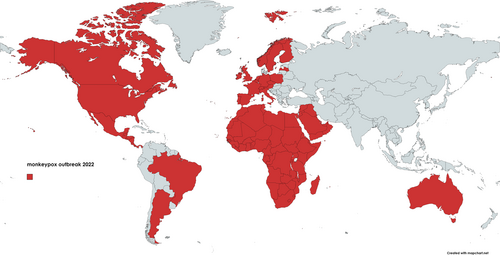Multicounty outbreak of monkeypox virus—Challenges and recommendations
1 INTRODUCTION
The World Health Organization (WHO) declared a multicountry outbreak of monkeypox virus from a nonendemic area, with the first confirmed case reported on May 7, 2022, of a person who had a history of traveling from the United Kingdom to Nigeria and returning back to the United Kingdom.1 Monkeypox virus was first found in 1958, and the first human patient infected with the virus was detected in 1970 in the Democratic Republic of Congo since then monkeypox was detected in several other geographical regions and later declared endemic by the WHO.2 The recent cases as of June 25, 2022 have been reported in Table 1 and the countries involved are shown in Figure 1.
| Countries | Confirmed | Suspected |
|---|---|---|
| Ghana | 18 | 0 |
| Argentina | 4 | 2 |
| Brazil | 11 | 9 |
| Canada | 235 | 44 |
| Mexico | 9 | 0 |
| United States of America | 173 | 0 |
| Venezuela (Bolivarian Republic of) | 1 | 0 |
| Morocco | 1 | 0 |
| United Arab Emirates | 13 | 0 |
| Austria | 20 | 0 |
| Belgium | 77 | 0 |
| Czech republic | 6 | 0 |
| Denmark | 13 | 0 |
| Finland | 4 | 0 |
| France | 330 | 0 |
| Georgia | 1 | 0 |
| Germany | 676 | 0 |
| Greece | 2 | 0 |
| Hungary | 12 | 0 |
| Iceland | 3 | 0 |
| Ireland | 28 | 0 |
| Israel | 16 | 0 |
| Italy | 127 | 1 |
| Latvia | 2 | 0 |
| Malta | 4 | 0 |
| Netherlands | 211 | 0 |
| Norway | 4 | 0 |
| Poland | 12 | 0 |
| Portugal | 348 | 0 |
| Romania | 5 | 0 |
| Slovenia | 8 | 0 |
| Spain | 736 | 2 |
| Sweden | 13 | 0 |
| Switzerland | 55 | 0 |
| The United Kingdom | 910 | 0 |
| Australia | 13 | 0 |
| Other countries | 15–20 | 20–30 |

The UK Health Security Agency (UKHSA) has declared that the fresh four cases in the United Kingdom have no history of travel to endemic areas and so far, the large majority of individuals reported to be infected are men who are involved in sexual activities with other men.3
The mode of transmission for the monkeypox virus occurs in a person in direct contact with an animal, human, or materials contaminated with the virus. The virus enters the body through abrasion or laceration in the skin, the mucous lining of the respiratory tract, and through direct contact or indirect contact with lesion material. Human-to-human transmission occurs through large respiratory droplets or through prolonged face-to-face contact.4, 5
The infection clinically manifests with fever, headache, muscle aches, and exhaustion, and in subsequent stages, it presents with lymphadenopathy and mild to painful skin rash. The incubation period usually ranges from 5 to 21 days.6 The case mortality rate ranges from 1% to 11%.7
For the current advances, recently the first draft genome sequence of monkeypox has been detected by a group in Portugal.8 MVA-BN vaccine (Imvamune or Imvanex), originally used for smallpox has been approved in the United States of America for monkeypox.9
2 CHALLENGES
Monkeypox originates from the orthopox genus and poxviridae family. As orthopox viruses are serologically cross-reactive, using antibody detection methods for monkeypox may produce false positives hence polymerase chain reaction (PCR) is recommended instead.4
The incidence of cases has risen significantly in recent years.10 Furthermore, the growing number of cases reported in nonendemic areas highlights the risk for geographical spread and the global relevance of the disease. With the current pandemic wrapping up, the public health departments around the world should embrace the importance of monkeypox disease before it escalates into an epidemic. Concurrent surveillance and accurate diagnosis of monkeypox cases are important tools for investigating the ever-changing epidemiology of this disease.11 Further, low-middle income countries may suffer due to lack of diagnostic facilities and virus detection in appropriate time.12
3 RECOMMENDATIONS
As the virus outbreak spreads, the clinicians are advised to educate themselves with the updated version of case definition from reliable sources like the CDC and the WHO. During the early stages of the rash, monkeypox presents similar symptoms to other skin infections therefore doctors are supposed to frame their diagnosis from accurate diagnostic laboratory tests such as the PCR.
At risk, individuals should use protection while having sexual intercourse. As a precaution, individuals should also have fewer sexual partners to reduce risk of transmission during this period. At the same time, informed decisions should be made by the healthcare system to timely make aware and benefit physicians and the general population.
CONFLICT OF INTEREST
The authors declare no conflict of interest.
Open Research
DATA AVAILABILITY STATEMENT
The data that support the findings of this study are openly available in Kraemer, Tegally, Pigott, Dasgupta, Sheldon, Wilkinson, and Schu at https://map.monkeypox.global.health/country.




